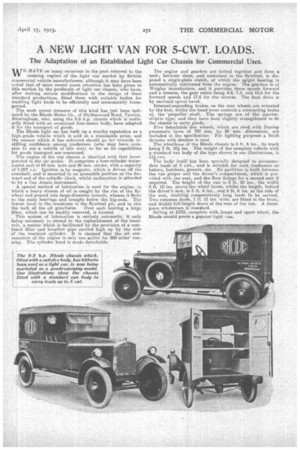A NEW LIGHT VAN FOR 5-CWT. LOADS.
Page 9

If you've noticed an error in this article please click here to report it so we can fix it.
The Adaptation of an Established Light Car Chassis for Commercial Uses.
WE HAVE OD many occasions in the past referred to the seeming neglect of the light van market by British commercial vehicle manufacturers, although it may have been noted that. of more recent years attention has been given to this market by the producers of light car chassis, who have, after making certain modifications in the design of their standard productions, fitted them with suitable bodies for enabling light loads to be efficiently and economically transported.
The most recent instance of this kind has just been-indicate-d by the Rhode Motor Co., of Blytheswood Road, Tyseley, Birmingham, who, using the 9.5 h.p chassis which is ordinarily fitted with an occasional four-seater body, have adapted it for the transport of goods.
The Rhode light car has built up a worthy reputation as a high-grade vehicle which is sold at a reasonable price, and tbe.success which it has achieved should go far towards instilling confidence among tradesmen (who may have occasion to use a vehicle of this sort) so far as its capabilities for goods transport are concerned.
The engine of the van chassis is identical with that incorporated in the car model. It comprises a four-cylinder watercooled unit of 62 mm. bore and 90 mm. stroke, with a capacity of 1,087 c.c. Ignition is by magneto, which is driven off the camshaft, and is mounted in an accessible position at the forward-end of the cylinder block, whilst carburation is attended to by a Cox Atmos instrument.
A special method of lubrication is used for the engine, in which a heavy stream of oil is caught by the rim of the flywheel and poured into large-diameter tunnels, whence it flows to the main bearings and troughs below the big-ends. The lowest level in the crankcase is the flywheel pit, and to this the bulk of the oil gravitates. Over each bearing a large filter, which can be readily removed, is located. This system of lubrication is entirely automatic, it only being necessary to attend to the replenishment of the reserveir, a matter which is facilitated by the provision of a combined filler and breather pipe carried high up by the side of the rearmost cylinder. It is claimed that the oil consumption of the engine is only one gallon for 800 miles' running. The cylinder head is made detuchable.
The engine and gearbox are bolted together and form a unit; between them, .and contained in the flywheel, is disposed a single-plate clutch, of which the spigot bearing is automatically lubricated from the engine. The gearbox is of Wrigley manufacture, and it provides three speeds forward and a reverse the gear ratios being 4.2, 7.3, and 13.6 for the forward speed's and 17.6 for the reverse. The final drive is by enclosed spiral bevel.
Internal-expanding brakes on the rear wheels are actuated by the foot, whilst the hand lever controls a contracting brake on the 'propeller shaft. The springs are of the quarterelliptic type, and they have been slightly strengthened to fit the chassis to carry goods.
Five detachable disc wheels, which are shod with Dunlop pneumatic tyres of 700 ram. by 80 • rem. dimensions, are included in the specification. For lighting purposes a Bruit dynamo with dimmer is used.
The wheelbase of the Rhode chassis is 8 ft. 6 ins., its track being 3 ft. 104. ins. The weight of the complete vehicle with a standard van body of the type shown in our illustrations, is 114 cwt.
The body itself has been specially designed to accommodate leads of 5 cwt., and is suitable for such tradesmen as bakers, butchers, grocers, etc. No partition is built between the van proper and the driver's compartment, which is •provided with one seat, and the floor fixings for a second seat if required. The height of the van is 3ft. 10 ins., the width 3 it. 10 ins, above the wheel boxes, whilst the length, behind the driver's seat, is 3 ft. 6 ins., and 6 ft. 6 in& at the side of , the seat, enabling comparatively long loads fo be carried. Two entrance doors, 1 ft. 11 ins, wide, are fitted at the front, and double full-length doors at the rear of the van. A threepiece windscreen is stanslard.
Selling at E235, complete with lamps and spare wheel, the Rhode mould prove a popular van.






























